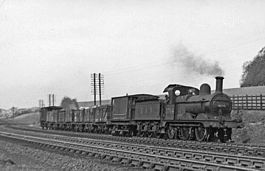- Chiltern Green railway station
-
Chiltern Green 
A local goods train near Chiltern Green in 1950 Operations Pre-grouping Midland Railway History 13 July 1868 Opened as Chiltern Green 1 December 1891 Renamed Chiltern Green for Luton Hoo 7 April 1952 Closed [1] Disused railway stations in the United Kingdom Closed railway stations in Britain
A B C D–F G H–J K–L M–O P–R S T–V W–ZRailways around Luton Legend
Midland Main Line 
Leagrave 


Branch to Dunstable 


Luton 


Luton Bute Street 


Luton Airport Parkway 





Luton Hoo 


Chiltern Green 





To Welwyn 


Midland Main Line Chiltern Green railway station was built by the Midland Railway in 1868 on its extension to St. Pancras.
The station was located in New Mill End but took its name from the small hamlet of Chiltern Green about a mile away. Adjacent to it was the GNR station of Luton Hoo also located in New Mill End. The small hamlet of New Mill End is unique in having two railway stations (Chiltern Green and Luton Hoo) neither of which, after 1st December 1891, were named after the village they served. The two lines ran side by side at this point, the Midland into Luton Midland Road, the GNR from Hatfield into Luton Bute Street.[2]
The station closed in 1952 due to competition from Luton Hoo station, only 600 yards (500 m) away. The station buildings survive to this day as a private home. The platform on the station building side partly survives but is overgrown and difficult to see when passing in a train. The other platform was removed when the line was electrified.
References
Coordinates: 51°51′0.9″N 0°22′10″W / 51.85025°N 0.36944°W
Closed railway stations in Bedfordshire Midland Main Line Varsity Line Husborne Crawley Halt · Wootton Broadmead Halt · Kempston and Elstow Halt · Bedford St John's (1st) · Willington · Blunham · Girtford Halt · Sandy (LNWR) · PottonBedford to Hitchin Line Cardington · Cardington Workmen's Platform · Southill · Shefford · Henlow CampDunstable Branch Line Other lines Categories:- Railway stations opened in 1868
- Railway stations closed in 1952
- Disused railway stations in Bedfordshire
- East of England railway station stubs
Wikimedia Foundation. 2010.
